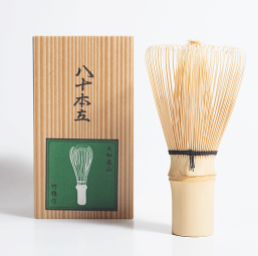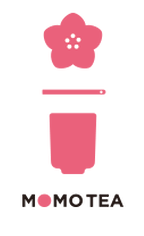|
On Wednesday March 14th the Tea Guild of Canada had a St Patrick’s Day with Matcha event. The presenters were Momo Yoshida of Momo Tea and Sorlie Madox and Helen Kong of Secret Teatime.
After attendees mingled over refreshments (including organic tofu and vegetable green rice makis), the program started with a Sencha tea (Japanese steamed green tea) being served and a brief presentation of matcha agriculture and it’s production process. This was followed by Momo demonstrating a tray-tea Chado service tea ceremony on a tatami mat (on the floor) while Sorlie and Helen spoke about this versatile and ritual way of making matcha. The meaning of Chado is Cha = tea and Do = path or road. Which translates as “The Way of Tea”. To master Chado, or The Way of Tea, is a lifetime of learning. There are different schools of tea. There are three historical households descended from the 16th-century tea master Sen no Rikyū. These three schools of tea are the Omotesenke, Urasenke, and Mushakōji. According to Sorlie, some Merchant schools of tea (like the ones that are practiced by the descendants of Rikyu) are slower and flashier than contemporary forms practiced by Samurai tea schools. We learned that in the spring a new tea of that year (usually tencha leaves which are used for making matcha) are placed into an urn and sealed and buried for the summer months to age. In the autumn the urn is opened in an important ritual marking a tea person’s New Year, or the Kuchi-kiri (opening of the tea urn). There is then a ceremony for the grinding of these tencha leaves into matcha. Gyokuro is like a sister to Matcha, as both of them are shaded for at least 20 days. This shuts out the direct sunlight to reduce the rate of photosynthesis resulting in high levels of theanine, the amino acid responsible for the full-bodied flavor of the matcha and gyokuro teas. There are two types of matcha preparation: Koicha and Usucha. Koicha is a very thick tea and looks like glossy paint. Historically it was considered medicinal and was also referred to as having a “dose” of tea. Usacha is a thin tea which whisks up into a foam on top. Momo pointed out something to be wary of. Make sure what you purchase is actually matcha and not ‘green tea powder’. Green tea powder is ground Sencha and is very bitter and not very nice tasting. Matcha is ground tencha leaves and is most flavourful and pleasing. Sencha, although an excellent tea when prepared correctly, is not a shaded tea and is not pleasant in a ground form
Shapes of Chawan:
Chasen Care:
3. Cleaning the tools
4. Preparing the matcha 5. Serving the matcha to guests 6. Completing the ceremony, cleaning of utensils (The guests need to inspect the tools used in the ceremony as a sign of respect and admiration for the host) How to drink the Matcha from the bowl during the ceremony: 1.Pick up your tea bowl using your right hand 2.Place the tea bowl on the palm of your left hand, and rotate it twice clockwise 3. Drink (with 3-4 sips, or 10 depending on the school). Make an audible slurp on the last sip 4. When you’re finished drinking, rotate the tea bowl twice counter-clockwise before placing it back in the original location 5. Admire the bowl People were encouraged to bring their own Chawans (tea bowls) and Chasens (bamboo whisks) and we had plenty on hand as well. There was quite an array of beautiful ceramic tea ware to behold! Participants had the opportunity for a hands-on experience of whisking and drinking matcha while being served wonderful matcha macaroons, coconut macaroons, and huge delicious organic daifuku (glutinous rice sweets filled with naturally flavoured and sweetened bean paste). There were two types of daifuku: Matcha and Yuzu (a Japanese citrus fruit). The word Daifuku translates as ‘Great Luck’ which was fitting for this St Patrick’s Day event! By Sarah Zinman
Pictures coming soon We had an exciting time tasting and learning about Tea Infused Cocktails with the creative and talented mixologist, Aaron Male. We also had some delicious refreshments provided by Raelene Gannon including Black Tea Cherry Fig Brownies and Matcha Chocolate cake. You can find the recipe for the Black Tea Cherry Fig Brownies HERE. Formerly a sous chef, Aaron Male is renowned for bringing his signature culinary flair to his cocktail creations. He is an entertaining raconteur and had us all fascinated by his adept mixing skills as well as his depth of knowledge and experience. And wow… he really lives up to his reputation. He prepared four fabulous Tea Infused Cocktails for us:
(Recipes at bottom) Infusion Conclusions: Calling the Kettle Black The Earl Grey, Johnny Walker whiskey, lemon, and maple in the Calling the Kettle Black created wonderfully satisfying layers of deep warmth. Up front was a comforting sweet oaky richness which then welcomed an almost invisible tang with just a little peat. This is a great winter cocktail. I can see this being a holiday season favourite. Chai Harder In the Chai Harder the spices in the Chai tea worked with the smoky Mezcal and spicy Mexican chili of the Ancho Reyes. The smokiness in the Mezcal is derived from being roasted in a pit covered with ash which produces the desired smoky and earthy notes. The smoky notes lingered for a long time while the heat from the Ancho quietly and slowly built at the back of the mouth, both complemented by spicy sweetness. Oolonging for You Under the Crescent Moon It was fun to smell the oolong emanating from the Oolonging for You Under the Crescent Moon! It was worth going to several LCBOs to find this special Beefeater gin. In addition to the usual Beefeater gin flavour ingredients (juniper, Seville oranges, angelica, coriander) it has added Japanese sencha, Chinese green, and hand prepared grapefruit rind. The Aperol created a wonderful deep burnt orange colour as well as a lasting citrus astringency, apricot notes, a cooling of juniper and oolong, and a wonderful intended bitterness. Eastern Medicine The Eastern Medicine served up as the lightest of the cocktails, and a popular one. It boasted hints of vanilla from the 2.5 year old Hennessy and a soft yet long and sweet finish with just the right amount of tartness courtesy of the Grand Marnier and lemon juice. All this was made more complex by the strongly steeped LongJing acting as taste enhancing bitters and creating balance. Aaron said a little added nutmeg would further enhance this cocktail. All the cocktails were perfectly balanced and thoroughly enjoyable. According to Aaron Male, in a good cocktail you should not taste any one ingredient over the others. It should never taste “too strong”, you should not taste “just the alcohol”, and none of the ingredients should be dominant, e.g. “the lime”. It should be completely balanced. Everything in harmony creating a complex experience. Aaron has a creative mind for combinations and flavours. What he appreciates about tea is, as he sees it, tea is a cocktail. He says tea is very complex, has layers of flavour notes, and is already very well structured. He loves adding different teas to any number of cocktail combinations. Working with Earl Grey he finds the bergamot enhances and compliments his favourite cocktail ingredients. Aaron boasts a large and overflowing drawer of tea which is a valuable storage space in the kitchen of a sous chef and mixologist! If you want to contact Aaron Male to do a party or an event, you can find him at [email protected] Tips:
Fun Facts:
Calling the Kettle Black (black tea / whiskey) 1.5oz Black Bottle Whiskey .5oz Pure Maple Syrup 2 oz Earl Gray tea unsweetened 1oz Lemon Juice Method: All ingredients in a shaker tin, shake with ice and pour into a collins glass filled with ice. Garnish: Lemon Twist Glass: Collins Chai Harder (black tea with spices / mezcal) 1.5 oz Mezcal Tellequache .5 oz Ancho Reyes .75 Simple Syrup .5 oz Lemon Juice 3 oz Chai Tea 2 Dashes Orange Bitters Method: All ingredients in a shaker tin, shake with ice and pour into a collins glass filled with ice. Garnish: Cinnamon Stick Glass: Collins Oolonging For You or Under the Crescent Moon (oolong tea / gin) 1.5 oz Beefeater 24 infused with Oolong Tea .75 oz Aperol Method: All ingredients in a shaker tin, shake with ice and pour. Garnish: Lemon Twist Glass: Coupe or small white wine glass /no ice Eastern Medicine (green tea / cognac) 1.5 oz Hennessy VS .5 oz Grand Marnier 2 oz Strong green tea chilled and unsweetened .5 oz fresh lemon juice 1 oz simple syrup Method: Combine all liquids in a shaker tin and shake until well chilled, strain into a Collins glass with fresh ice. Garnish: Mint Sprig Glass: Collins Do you know where Tea, the second most consumed beverage globally after water originated? Which countries grow and produce tea? What regions of the world have a Tea drinking history? For a brief history, geography, economy and politics of Tea, click to view below Ted-Ed video for 'The History of Tea'. (Animation by Steff Lee.) |
AuthorWrite something about yourself. No need to be fancy, just an overview. Archives
March 2018
Categories |







 RSS Feed
RSS Feed
